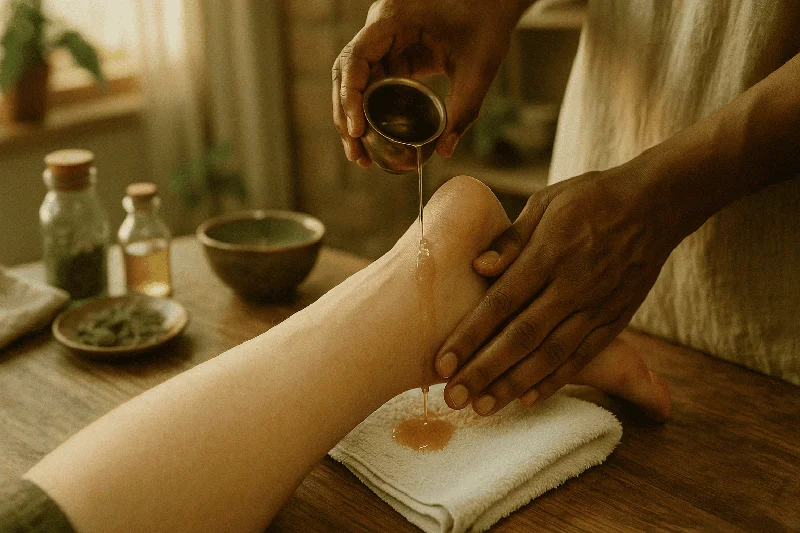Shop Now in Our Store
Ayurvedic Treatment for Plantar Fasciitis: Natural Relief for Foot Pain

Plantar fasciitis, a common cause of heel pain, affects individuals across all age groups and activity levels. This condition occurs when the plantar fascia, a thick band of tissue running along the bottom of the foot, becomes inflamed or strained. While modern medicine offers treatments such as pain relievers and physical therapy, Ayurveda provides holistic remedies that address the root cause and promote long-term healing. In this article, we will explore effective Ayurvedic treatments for plantar fasciitis, their benefits, and how to incorporate them into your wellness routine.
What is Plantar Fasciitis?
Plantar fasciitis is characterized by stabbing pain near the heel, especially during the first steps in the morning or after prolonged periods of inactivity. Contributing factors include:
-
Overuse or excessive physical activity
-
Improper footwear
-
Obesity or excessive weight
-
Prolonged standing
-
Poor foot biomechanics
Ayurveda views plantar fasciitis as a disorder caused by an imbalance of Vata dosha, leading to dryness and inflammation in the tissues. Ayurvedic treatments focus on reducing inflammation, soothing pain, and restoring balance.
Ayurvedic Remedies for Plantar Fasciitis
1. Abhyanga (Oil Massage)
Abhyanga involves massaging the feet with warm medicated oils to improve blood circulation, reduce pain, and relax the muscles. Recommended oils include:
-
Mahanarayan Oil: Known for its anti-inflammatory properties, this oil alleviates pain and promotes healing.
-
Ksheerabala Oil: Helps in reducing stiffness and improving mobility.
2. Pinda Sweda (Herbal Poultice Therapy)
Pinda Sweda involves the application of a warm herbal poultice to the affected area. This therapy reduces inflammation and provides relief from pain. Herbs like Dashamoola and Nirgundi are commonly used in the poultice.
3. Vasti (Medicated Enema)
Vasti is a detoxification therapy that helps balance Vata dosha, which is often the root cause of plantar fasciitis. It improves overall joint and muscle health, aiding in long-term recovery.
4. Herbal Remedies
-
Ashwagandha: Reduces inflammation and strengthens muscles.
-
Guggulu: Known for its anti-inflammatory and pain-relieving properties, Guggulu is effective in treating plantar fasciitis.
-
Turmeric: Curcumin in turmeric acts as a natural anti-inflammatory agent, reducing swelling and pain.
5. Hot and Cold Therapy
Alternate hot and cold compresses can alleviate pain and inflammation. Ayurveda suggests combining this therapy with herbal decoctions for enhanced benefits.
Ayurvedic Diet for Plantar Fasciitis
A balanced diet can support the healing process. Ayurveda recommends:
-
Including anti-inflammatory foods like ginger, turmeric, and green leafy vegetables.
-
Consuming warm, easily digestible meals to balance Vata dosha.
-
Avoiding cold and dry foods that can aggravate inflammation.
Yoga and Stretching for Plantar Fasciitis
Gentle yoga poses and stretching exercises can strengthen the foot muscles, improve flexibility, and reduce pain. Recommended poses include:
-
Tadasana (Mountain Pose): Enhances posture and strengthens the feet.
-
Vrikshasana (Tree Pose): Improves balance and stretches the plantar fascia.
-
Downward Dog Pose: Relieves tension in the calves and heels.
Benefits of Ayurvedic Treatment for Plantar Fasciitis
-
Holistic Approach: Treats the root cause of the condition rather than just the symptoms.
-
Natural Remedies: Uses herbal and natural treatments without harmful side effects.
-
Long-Term Relief: Promotes sustainable healing and prevents recurrence.
Precautions and Considerations
-
Consult an Ayurvedic practitioner to determine the most suitable treatments for your condition.
-
Avoid overexertion and wear supportive footwear during the recovery process.
-
Combine Ayurvedic treatments with physiotherapy for optimal results.
Conclusion
Ayurvedic treatment for plantar fasciitis offers a holistic and natural way to alleviate pain and promote healing. By incorporating therapies like Abhyanga, herbal remedies, and yoga into your routine, you can address the root cause of the condition and enjoy long-lasting relief. Whether you’re dealing with mild discomfort or chronic pain, Ayurveda provides safe and effective solutions to improve your quality of life. Begin your journey to pain-free feet today with Ayurveda!
This article is checked by the current qualified Dr Sujal Patil and can be considered a reliable source of information for users of the site.
Got any more questions?
Ask Ayurvedic doctor a question and get a consultation online on the problem of your concern in a free or paid mode.
More than 2,000 experienced doctors work and wait for your questions on our site and help users to solve their health problems every day.

